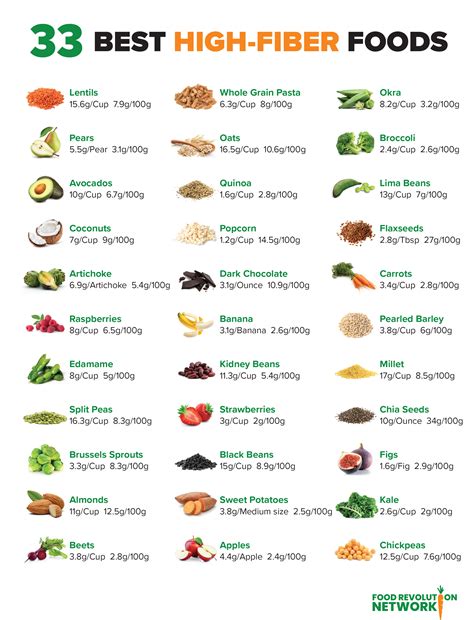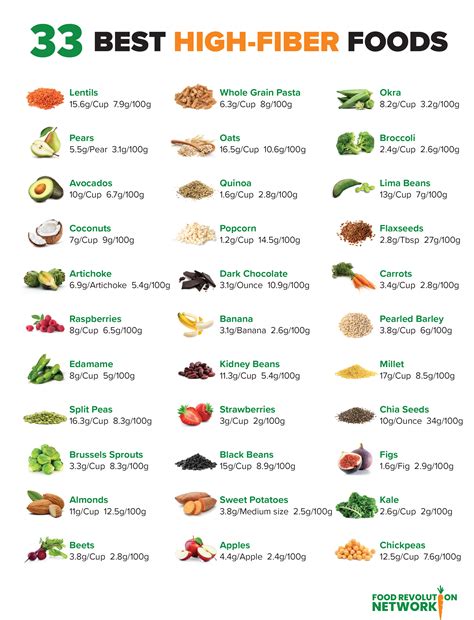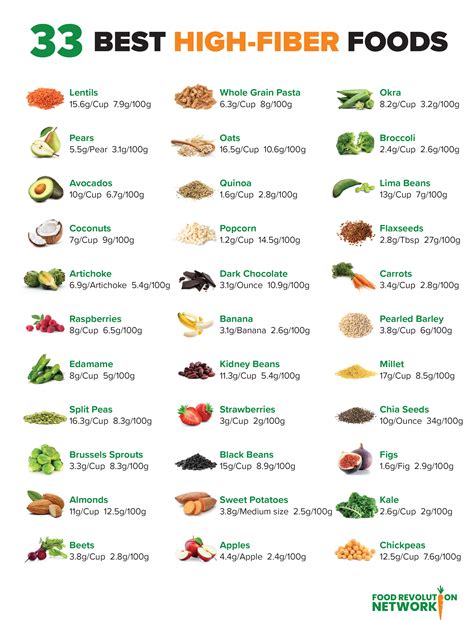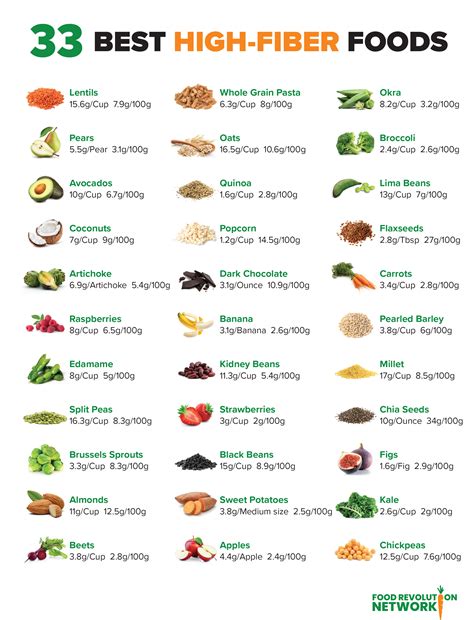Intro
Boost health with high fiber food benefits, including digestive health, weight loss, and lowered cholesterol, through nutrient-rich whole foods like fruits, vegetables, and legumes.
The importance of incorporating high fiber foods into our daily diets cannot be overstated. A high fiber diet has been shown to have numerous health benefits, ranging from promoting digestive health to reducing the risk of chronic diseases such as heart disease and diabetes. Despite these benefits, many of us fail to consume the recommended daily intake of fiber, leading to a range of negative health consequences. In this article, we will delve into the world of high fiber foods, exploring their benefits, types, and ways to incorporate them into our diets.
A diet rich in fiber can have a significant impact on our overall health and wellbeing. Fiber plays a crucial role in maintaining a healthy digestive system, preventing constipation, and supporting the growth of beneficial gut bacteria. Additionally, a high fiber diet has been shown to help lower cholesterol levels, regulate blood sugar levels, and even aid in weight management. With so many benefits, it's no wonder that health experts and nutritionists recommend consuming a diet rich in high fiber foods.
The benefits of a high fiber diet are numerous and well-documented. From reducing the risk of chronic diseases to promoting digestive health, the advantages of incorporating high fiber foods into our diets are clear. However, with so many different types of fiber-rich foods available, it can be difficult to know where to start. In the following sections, we will explore the different types of high fiber foods, their benefits, and ways to incorporate them into our diets.
Introduction to High Fiber Foods

High fiber foods are those that contain a significant amount of dietary fiber, a type of carbohydrate that is not easily broken down by the body. Instead, fiber passes through the digestive system relatively intact, providing a range of health benefits along the way. There are two main types of fiber: soluble and insoluble. Soluble fiber dissolves in water, forming a gel-like substance that helps to slow down digestion and absorb nutrients. Insoluble fiber, on the other hand, does not dissolve in water and helps to add bulk to stool, promoting regular bowel movements.
Types of High Fiber Foods
High fiber foods can be found in a variety of different food groups, including fruits, vegetables, whole grains, and legumes. Some examples of high fiber foods include: * Fruits: apples, bananas, berries, and citrus fruits * Vegetables: broccoli, carrots, Brussels sprouts, and sweet potatoes * Whole grains: brown rice, quinoa, whole wheat bread, and whole grain pasta * Legumes: beans, lentils, chickpeas, and peasBenefits of a High Fiber Diet

A high fiber diet has been shown to have numerous health benefits, including:
- Promoting digestive health: fiber helps to regulate bowel movements, prevent constipation, and support the growth of beneficial gut bacteria
- Lowering cholesterol levels: soluble fiber helps to bind to bile acids and remove them from the body, reducing the amount of cholesterol produced in the liver
- Regulating blood sugar levels: fiber helps to slow down the absorption of sugar into the bloodstream, preventing spikes in blood sugar levels
- Aiding in weight management: fiber helps to keep us feeling full and satisfied, reducing the likelihood of overeating
How to Incorporate High Fiber Foods into Your Diet
Incorporating high fiber foods into your diet can be easy and delicious. Here are some tips to get you started: * Start your day with a high fiber breakfast: try oatmeal with fruit and nuts, or whole grain toast with avocado and eggs * Snack on high fiber fruits and vegetables: try baby carrots with hummus, or an apple with almond butter * Incorporate legumes into your meals: try adding beans to your favorite soups and stews, or making a big batch of lentil soup on the weekend * Choose whole grains over refined grains: try brown rice instead of white rice, or whole wheat bread instead of white breadHigh Fiber Food Options

There are many different high fiber food options available, making it easy to incorporate them into your diet. Here are some examples:
- Fruits:
- Apples (1 medium: 4.5 grams of fiber)
- Bananas (1 medium: 3.1 grams of fiber)
- Berries (1 cup: 3.8 grams of fiber)
- Vegetables:
- Broccoli (1 cup: 5.1 grams of fiber)
- Carrots (1 cup: 3.7 grams of fiber)
- Brussels sprouts (1 cup: 5.6 grams of fiber)
- Whole grains:
- Brown rice (1 cup: 3.5 grams of fiber)
- Quinoa (1 cup: 5.2 grams of fiber)
- Whole wheat bread (1 slice: 3.8 grams of fiber)
- Legumes:
- Beans (1 cup: 9.5 grams of fiber)
- Lentils (1 cup: 15.6 grams of fiber)
- Chickpeas (1 cup: 12.5 grams of fiber)
High Fiber Food Recipes
Here are some delicious and easy-to-make high fiber food recipes to try: * High fiber breakfast bowl: mix together rolled oats, almond milk, and chopped fruit, then top with nuts and seeds * Lentil soup: sauté onions, garlic, and carrots, then add lentils, broth, and diced tomatoes * Grilled chicken and vegetable skewers: alternate chicken and vegetables such as bell peppers, onions, and mushrooms on skewers, then grill until cooked throughConclusion and Next Steps

Incorporating high fiber foods into your diet can have a significant impact on your overall health and wellbeing. With so many delicious and easy-to-make high fiber food options available, there's no excuse not to start making the switch today. Remember to start slowly, incorporating one or two high fiber foods into your diet each day, and gradually increase your intake over time. With a little creativity and experimentation, you can create a high fiber diet that is both delicious and nutritious.
Final Thoughts
In conclusion, high fiber foods are an essential part of a healthy and balanced diet. With their numerous health benefits, delicious taste, and ease of incorporation, there's no reason not to make the switch to a high fiber diet today. So go ahead, get creative, and start experimenting with new high fiber food recipes and options. Your body – and taste buds – will thank you!What are the benefits of a high fiber diet?
+A high fiber diet has been shown to have numerous health benefits, including promoting digestive health, lowering cholesterol levels, regulating blood sugar levels, and aiding in weight management.
What are some examples of high fiber foods?
+High fiber foods include fruits such as apples, bananas, and berries, vegetables such as broccoli, carrots, and Brussels sprouts, whole grains such as brown rice, quinoa, and whole wheat bread, and legumes such as beans, lentils, and chickpeas.
How can I incorporate more high fiber foods into my diet?
+Incorporating high fiber foods into your diet can be easy and delicious. Try starting your day with a high fiber breakfast, snacking on high fiber fruits and vegetables, incorporating legumes into your meals, and choosing whole grains over refined grains.
We hope you found this article informative and helpful in your journey to a high fiber diet. If you have any questions or comments, please don't hesitate to reach out. Share this article with your friends and family to help spread the word about the importance of high fiber foods. Together, we can create a healthier and more balanced community, one high fiber meal at a time!
